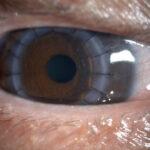Digital eye strain also known as computer vision syndrome, is a condition where a person experiences a temporary eye discomfort after prolonged use of electronic devices such as computer, tablet, mobile devices. The level of discomfort increases with the amount of digital screen use. DES can occur differently in each individual based on their visual device lifestyle, but their symptoms are usually the same.
Symptoms of DES
The most common symptoms associated with digital eye strain are
eye fatigue and discomfort
blurred vision
headache and neck pain
back and shoulder pain
Causes of DES
- Reduction of blinking when staring at electronic devices is one of the reasons people experience DES. A person normally will blink about 15 times per minute. However, the blinking rate can be less than half when a person continuously stares at the screen.
- Glare can occur on devices with glass screens which contribute to DES due to the reflection and brightness of the screen.
- Improper viewing distance by staring at the computer at a too close or too far distance for a long time can cause DES.
- Poor seating position while staring at the screen at a different height level can lead to many problems such as headache and neck and shoulder pain. This is because the position of the eye viewing is not parallel to the screen.
- Uncorrected vision problems such as short-sightedness, astigmatism, presbyopia and underlying eye problems can easily cause a person to be more symptomatic towards DES.
- Contact lens wear can increase the chance of having dry eyes and irritation.
Treatment & Prevention of DES
- Taking a break frequently while looking at a screen for long hours is very important. By practicing the “20-20-20” rule, for every 20 minutes look away from the screen and look at an object 20 feet away for at least 20 seconds. This allows the eyes to rest and refocus themselves.
- Reducing glare by adjusting the brightness on the screen or dimming the light near the screen can help to reduce the DES. An additional matte screen filter on top of the screen can also help.
- Ergonomics is crucial in the working environment.
a) Adjusting the seating position while looking at the screen for long hours is important to prevent neck strain and shoulder pain while working. The chairs must be comfortably padded and conform to the body and the chair height should be adjusted so the feet rest flat on the floor. Arms have to be adjusted to provide support while typing and wrists shouldn’t rest on the keyboard when typing.
b) Location of the computer screen should be 15 to 20 degrees below eye level (about 4 or 5 inches) as measured from the center of the screen and 20 to 28 inches from the eyes. Most people find it more comfortable by viewing the computer with their eyes looking downward.
c) The arrangement of reference materials has to be below the monitor and above the keyboard. Otherwise, a document holder can be placed beside the monitor. The reason for positioning the documents is to reduce the head effort to reposition from the document to the screen. - Correct refractive errors and underlying eye problems by visiting an optometrist or ophthalmologist for proper management and eye prescription in order to have a better vision performing daily tasks.
- Contact lens wearers can consider having a pair of glasses while staring at the devices for long periods especially during working hours. Using artificial tears to lubricate the eyes with or without contact lenses can reduce symptoms.
Digital eye strain can be diagnosed through a comprehensive eye examination. During the exam, it is important to tell your Ophthalmologist how often you use a computer or digital device at home or work. Generally an eye strain can be treated with simple methods, however, prolonged eye strain and discomfort may be a sign of something serious that should be treated by an Ophthalmologist.
Those living in areas such as Shah Alam, Cheras, Puchong, Shah Alam, Petaling Jaya, and Kepong can come visit our ophthalmologists to have their eyes examined.






